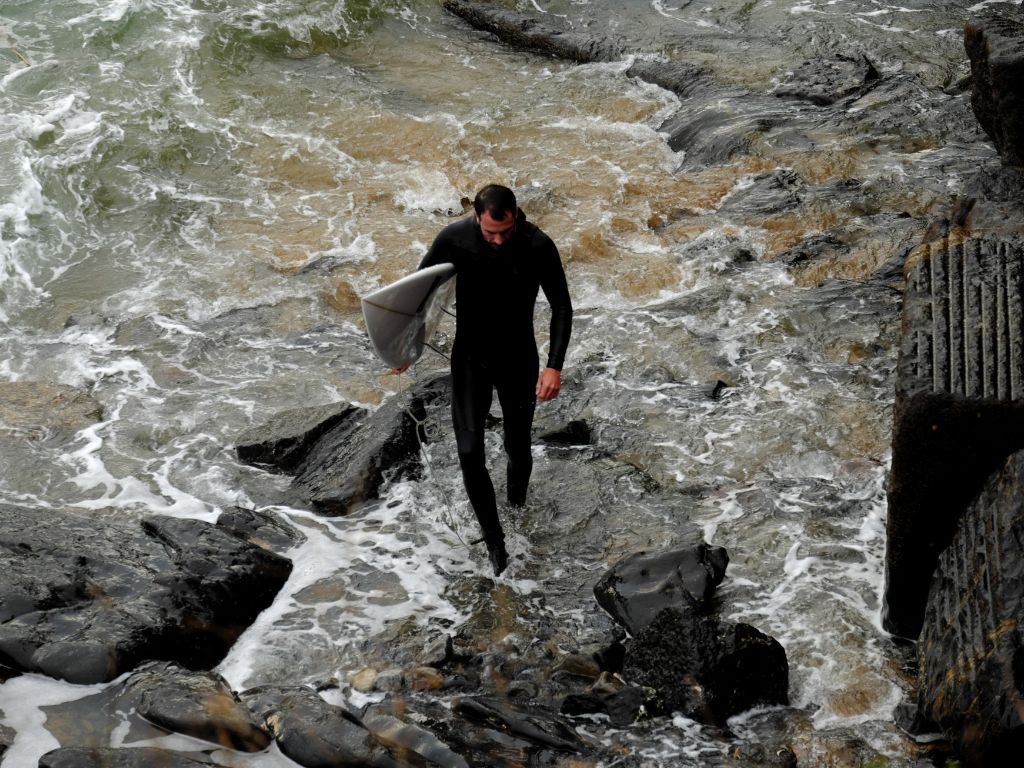Swimming and surfing are both quite demanding, both physically and mentally. Everyday clothing isn’t ideal for watersports; and I wouldn’t wanna bet on an ordinary swimsuit in cold, harsh waters. That’s where wetsuits come into play.
Technically, surfing wetsuits aren’t ideal for swimming, and vice versa. If you’re just starting out and have a surfing wetsuit lying around, go on and make the best out of it. But if you’re hitting the waters regularly, opt for dedicated swimming wetsuits.
While wetsuits for swimming and surfing have similarities, some key differences are catered towards their specific purposes, i.e., swimming and surfing. For the sake of context, let’s have a look at the key differences between swimming and surfing wetsuits.
1. Key Differences: Swimming vs. Surfing Wetsuits
To state the obvious, surfing wetsuits are more suitable for surfing. In contrast, dedicated swimming wetsuits are the pinnacle of swimming fits. Apart from this, a few key differences affect your experience as a swimmer. Let’s dive deeper (no pun intended).
| PROPERTY | SURFING WETSUIT | SWIMMING WETSUIT |
| Thickness | Thicker overall [4-5mm] | Usually thinner [1.5-3mm] |
| Buoyancy | Buoyancy-focused, thicker neoprene means more buoyant throughout. | Focused on keeping the swimmer streamlined, targeted buoyancy. |
| Flexibility | Sturdy fit, often with reinforcements of thicker material at kneecaps. | Flexible fit, designed to match the movements of a swimmer’s arms and neck. |
| Cost | Entry-level, reliable surfing wetsuits are available for 90-100 USD. | Entry-level triathlon wetsuits start at around 180 USD. |
A. Thickness
Wetsuits are made of materials like Neoprene which are essential for water-proofing. The thickness of Neoprene used has a direct effect on the dynamics of the wetsuit.
Surfing wetsuits are generally thicker throughout the body, typically with extra reinforcement around the kneecaps. Swimming wetsuits, on the other hand, are usually thinner.
Dedicated swimming wetsuits care more about hydrodynamics. The armpits have a thinner layer of Neoprene, while the hip area is buffed up. There is also a market for swimming wetsuits designed to take off easily. It’s not a feature everyone cares about, but you can benefit from things like a Triathlon.
B. Buoyancy
The biggest plus point of wetsuits is their ability to keep you afloat, aka buoyancy. Neoprene absorbs a minuscule amount of water and helps boost buoyancy.
While swimming and surfing wetsuits aim to increase buoyancy, they do it differently. Surfing wetsuits focus on buoyancy, and the extra neoprene padding aids greatly. Swimming wetsuits tend to focus more on keeping you streamlined than keeping you afloat.
Swimming wetsuits have different thicknesses of neoprene around specific target areas known to affect swimmers.
C. Flexibility
The cut of a wetsuit governs how you feel as you swim while wearing one. Surfing wetsuits are more into the sturdiness department rather than flexibility.
Surfing wetsuits tend to have an overall thick fit while swimming wetsuits have a different cut, and a lower neck, focusing on easing out movements for the swimmer.
D. Cost
The cost of surfing and swimming wetsuits varies widely among brands, styles, and specific designs.
Surfing wetsuits are often cheaper than dedicated swimming wetsuits. You must prefer swimming wetsuits or triathlon wetsuits if you have a competitive event coming up. For casual swimming, though, a surfing wetsuit is still viable and might save you some bucks.
Inexpensive wetsuits usually have fewer panels than expensive ones, which implies that the fit in cheaper wetsuits isn’t as great as in the costly ones. The same can be said for leakage resistance. Costlier wetsuits are blindstitched and allow no water to seep in.
2. Should you use surfing wetsuits for swimming?
So, should you? Well, yes and no. Let’s find out.
A. Advantages of Using Surfing Wetsuits for Swimming
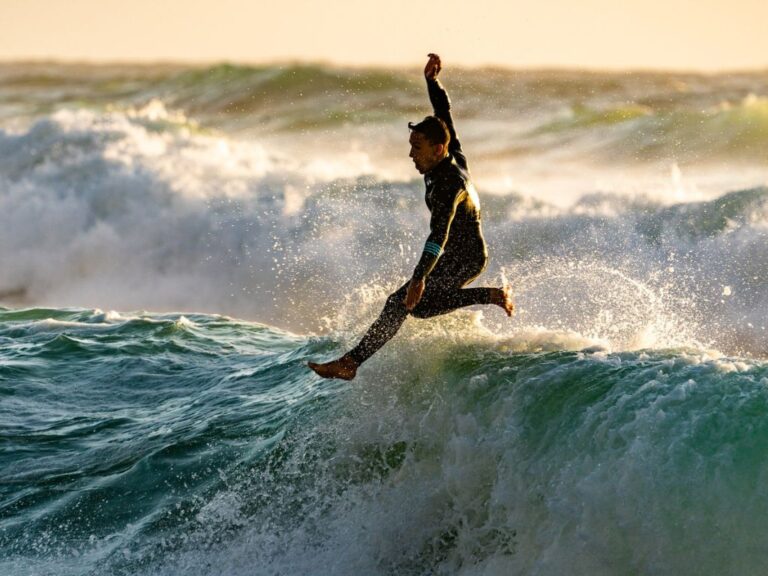
I. Extra Buoyant
Surfing wetsuits tend to be thicker to counter the slash and tear of fierce waves. Extra buoyancy can greatly help swimmers — it won’t be as hard to stay afloat.
This is an excellent feature for beginner swimmers or those struggling to stay afloat. For older swimmers, it helps reduce fatigue during longer swim sessions and improve overall performance.
II. Warmth
Have you ever jumped into a cold pool or lake and felt a chilling shock? It’s not a pleasant sensation. A wetsuit might just be the kryptonite for that.
Swimming wetsuits help keep you warm, but surfing wetsuits provide more insulation and warmth. Surfing wetsuits are a big plus for those who live in colder climates or open-water swimmers who go to the depths of water bodies and encounter colder temperatures.
III. UV-Protection
Sunbruns and chafing are worrisome factors that hold back your performance while surfing or swimming. A wetsuit protects you from the scorching sun and the invisible UV spectrum it emits.
Surfing wetsuits cover up more of your skin than dedicated swimming ones do. This, in a way, results in enhanced protection against the sun. Surfing wetsuits are also less likely to cause rashes, thanks to a looser fit.
B. Drawbacks of Using a Wetsuit for Swimming
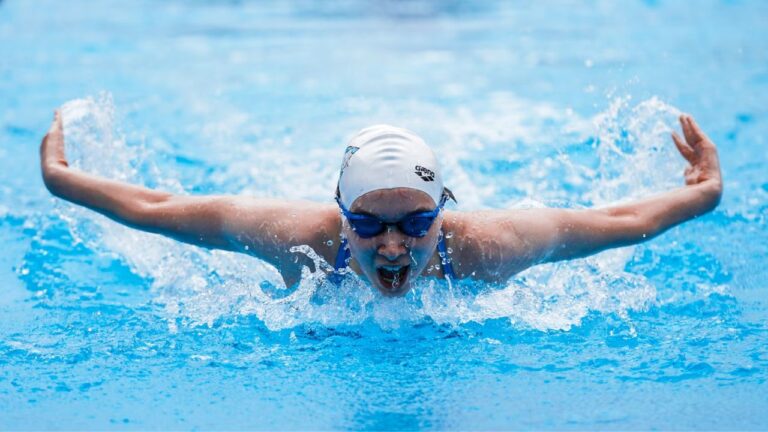
I. Higher Drag
Surfing wetsuits are typically bulkier and produce more drag than swimming wetsuits. Swimming wetsuits are dedicated to reducing drag where needed.
Every swimmer and every wetsuit is unique. Most often, surfing wetsuits have a manageable drag boost, but if that works for you is something you have to determine yourself. You can enjoy a more relaxing swim when you’re not fighting with the water as much.
II. Unwanted buoyancy
But having the ability to never drown must always be a positive, right? Certainly not if you’re trying to move your limbs to push the water off. Surfing wetsuits have both an advantage and a drawback regarding the extra buoyancy they provide.
On the one hand, buoyancy can make it easier for you to stay afloat. On the other hand, you’ll have to work harder to move your arms since surfing wetsuits don’t have thinner armpits as dedicated swimming wetsuits do.
If you like breaststrokes, surfing wetsuits are not for you. The ankle area in surfing wetsuits is thick, making them unfavorable for techniques like breaststrokes.
The pros and cons of a surfing wetsuit for swimming are interchangeable depending on the person, type of swim, and location. For instance, if you’re sensitive to warmer temperatures, the warmth of a surfing wetsuit might become an issue for you instead of a feature.
III. Lack of Flexibility
Both surfing wetsuits and swimming wetsuits serve the purpose of keeping you warm. But they are not equal regarding flexibility, as we discussed earlier. Does this count as a drawback, though? Yes, it does.
Swimming wetsuits target key areas in the body and are much more flexible than surfing wetsuits. The snug fit and panel placement help with the different kinds of strokes a swimmer is expected to perform. This makes them the perfect choice for competitive swimming as opposed to casual.
3. Best Surfing Wetsuits – My Top Picks
Surfing wetsuits are the way to go if you’re just starting out. They’re cost-effective and do the job. Of course, the best way to determine what’s best for you is to try it on yourself. Here’s a list of our top 3 picks to assist you with your decision.
Editor’s Pick: O’Neill Psycho Tech Wetsuit
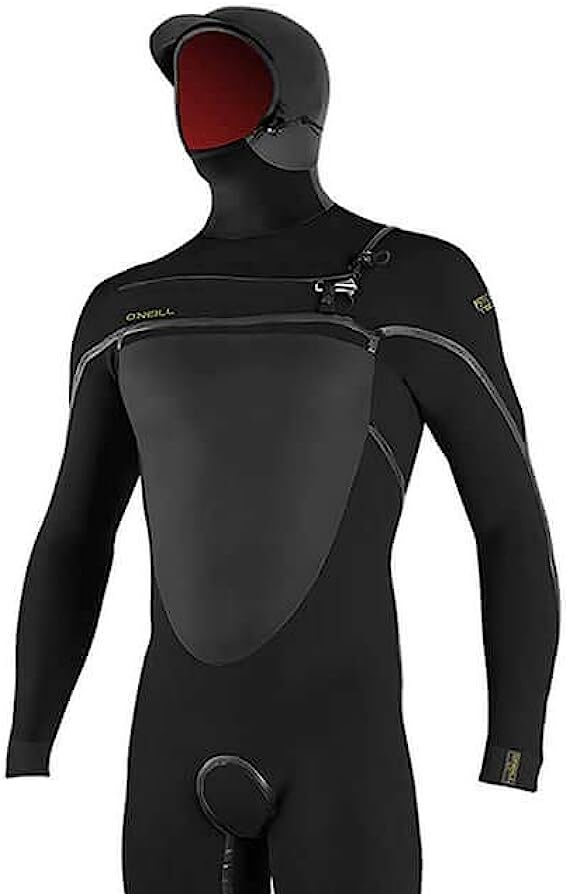
Psycho Tech Wetsuit
Those who love spending longer in the water know how important it is to have a wetsuit that keeps you warm and comfortable. The O’Neill Psycho Tech Wetsuit delivers on both fronts.
Ideal: Quiksilver M-Sessions
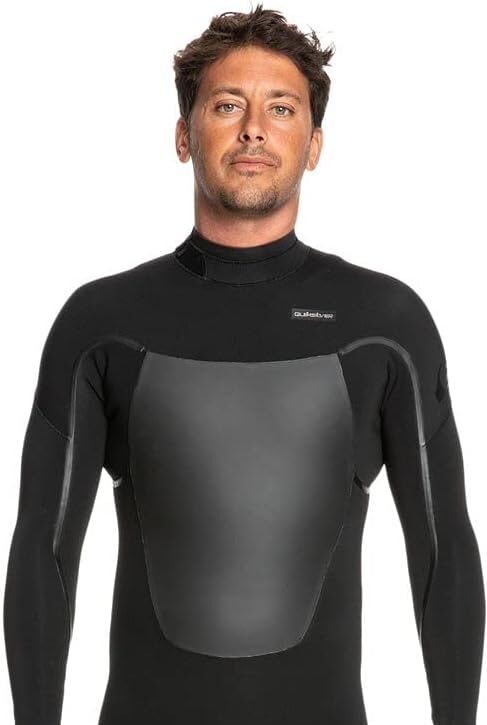
M-Sessions
The Quiksilver M-Sessions suit is competitively priced, given its premium quality in the sub-250 dollar range. It’s made of Limestone derivate eco-friendly Neoprene and is Glued and blindstitched [GBS].
Budget: Billabong Men’s Foil
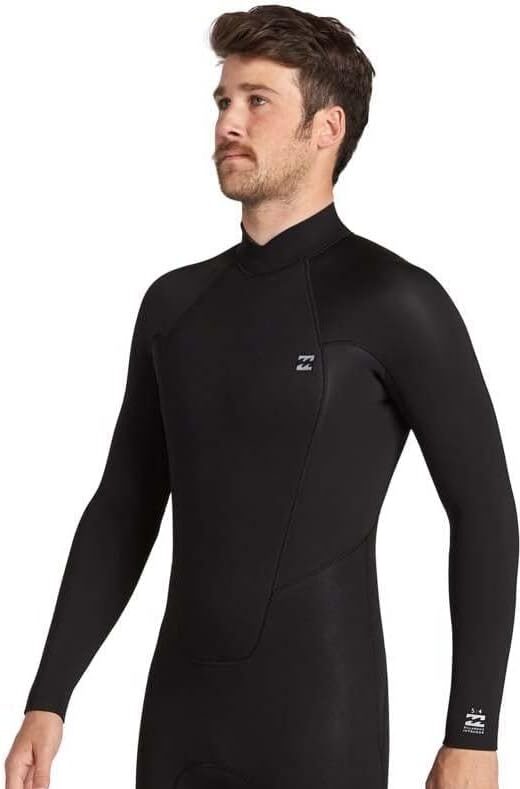
Billabong Men’s Foil
One of the budget options, but it does not compromise on quality. The Billabong Men’s foil is on the tighter side as far as fit is concerned. Only a few wetsuits offer GBS in this price range.
4. How to choose one?
Looking for surfing wetsuits? The market isn’t exactly saturated, but there are still many options. The product descriptions can be overwhelming, especially if you’re new to this. Let’s go through some essential features to look out for.
A. Thickness
The thickness of your wetsuit determines how much warmth it provides. There are various thicknesses available, each for a different water temperature. Refer to a buying chart before making your decision.
B. Entry Method
There are different ways to get into a wetsuit. Might be using a zip at the chest or on the back or no zip at all! The back-zipped ones are typically the easiest to handle.
C. Fit/Size
A wetsuit is not independent of chest and waist sizes, so buy the right one. Remember that you need to be a little accurate here since larger sizes result in a loose fit, defeating the purpose of a wetsuit.
D. Seam
Wetsuits come with different seams: flatlock, blindstitched, and sealed. Flatlocks tend to be leak-prone. I won’t go with one if I am interested in cold, harsh waters.
E. Waterproofing
Wetsuits are not “waterproof.” That’s a dry suit for you. When discussing waterproofing in wetsuits, we refer to the suit’s ability to resist unwanted leakages. Sealed wetsuits tend to be much more leak-resistant than other kinds.
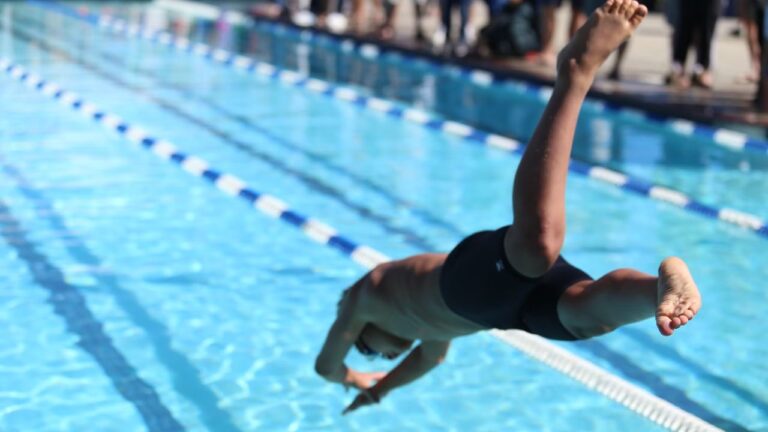
5. Alternatives to Surfing Wetsuits for swimming
While wetsuits are the standard, Neoprene might not be for everyone. Maybe you are allergic to Neoprene or prefer a specialized swimming wetsuit over a surfing one. You may be looking for a cheaper alternative to keep warm in the water. Here are some alternatives to a wetsuit for swimming:
A. Neoprene-free Wetsuits
If you are allergic to Neoprene or simply wish to avoid it, you can opt for Neoprene-free wetsuits. The best ones I have seen are from Patagonia. They’re made of natural rubber and devoid of any Neoprene traces.
B. Swimsuits
Swimsuits are a much lighter version of wetsuits with limited functionality. If you’re torn between a swimsuit and a wetsuit, remember that swimsuits are more suitable for warmer temperatures where cold resistance isn’t a priority.
As for swimsuits, they’re easier to store, handle and maintain and are usually cheaper than full-fledged wetsuits. Suppose you’re looking to enjoy a simple swim in backyard waters. In that case, a swimsuit might be the best choice!
C. Rash Vests
A rash vest or a rash guard is yet another alternative to a wetsuit. Although cold resistance and buoyancy are much different, it is a cheaper alternative.
You can swim and surf with a rash vest, but do not expect the warmth or durability of a wetsuit. What you can expect, though, is a considerably lower price than wetsuits.
Expert QnA
Q. How thick should an open-water swimming wetsuit be?
The ideal thickness for open-water swimming wetsuits is usually around 3 mm on the upper body and 5 mm on the lower body. The thickness can vary depending on the water temperature you will swim in. Colder waters require thicker wetsuits.
Q. How much does a swimming wetsuit cost?
Entry-level full-body wetsuits can be anywhere from 100 bucks to 200 bucks. Anything above the 300-dollar mark is often considered premium.
Q. How to clean a surfing wetsuit?
To clean a wetsuit, get a tub of water, put some wetsuit cleaner in it, and stir well. Turn the wetsuit upside down, put it in the water, and let it soak in the mixture. Rub and knead it well for a while. Finally, rinse and dry the wetsuit.

